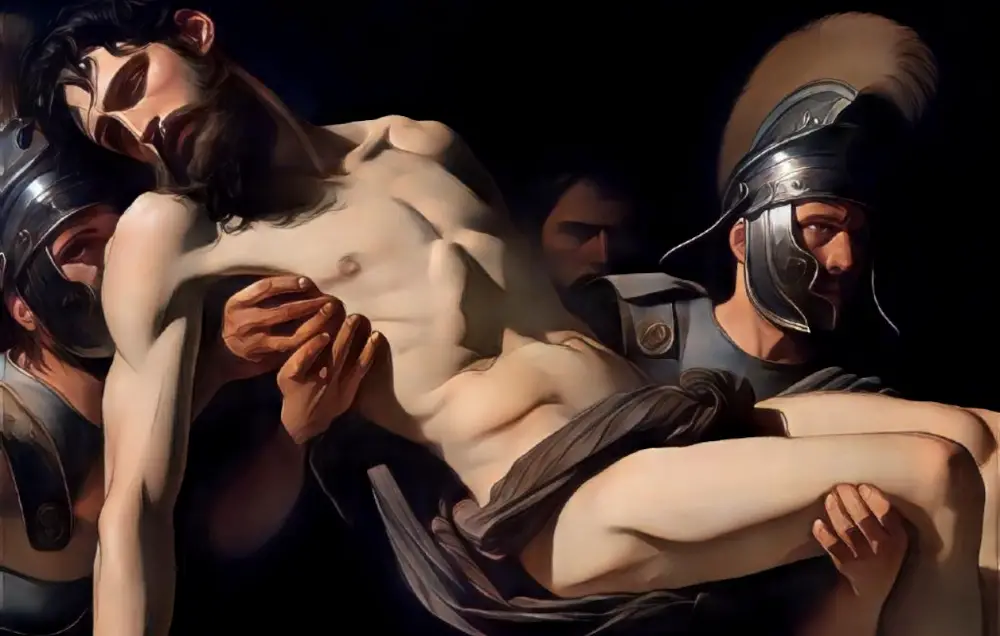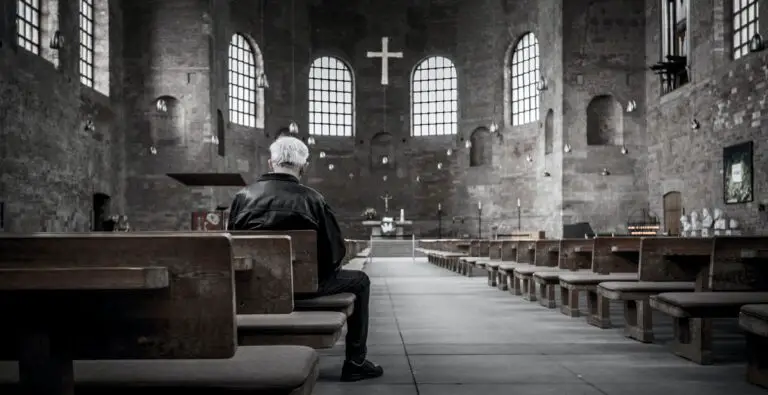Could it be true? Did Jesus really rise from the dead, just as he predicted?
Many skeptics dismiss the resurrection as a myth or legend. But when we examine the evidence, a compelling case emerges that Jesus conquered death and appeared alive to his followers.
Let’s look at 7 pieces of evidence that support the historicity of the resurrection.
1. The Empty Tomb

According to the Gospels, Jesus was buried in Joseph of Arimathea‘s tomb on Friday evening.
When the women returned on Sunday morning, they found the heavy stone had been rolled away and the tomb was empty.
“2 Very early on the first day of the week, just after sunrise, they were on their way to the tomb 3 and they asked each other, “Who will roll the stone away from the entrance of the tomb?” 4 But when they looked up, they saw that the stone, which was very large, had been rolled away.”
Mark 16:2-4 (NIV)
biblegateway.com
If Jesus did not resurrect, what happened to his body? Both Roman and Jewish authorities had the motivation to produce a corpse if it existed. But early critics never denied that the tomb was vacant on Easter morning.
The empty tomb was documented early and by multiple sources (Mark 16:1-8; Matthew 28:1-10; Luke 24:1-12; John 20:1-9).
2. Post-Resurrection Appearances of Jesus

For 40 days after his death, Jesus appeared alive to his followers. These appearances were often intimate, conversational, and sometimes included physical contact.
On a few occasions, Jesus appeared to skeptical unbelievers like James (the brother who doubted him prior to Easter) or Paul (an enemy of the church).
The resurrection appearances were numerous and occurred in diverse circumstances, recorded by multiple eyewitnesses.
Paul passes on an early creed that over 500 saw the risen Christ at one time.
“3 For what I received I passed on to you as of first importance: that Christ died for our sins according to the Scriptures, 4 that he was buried, that he was raised on the third day according to the Scriptures, 5 and that he appeared to Cephas, and then to the Twelve. 6 After that, he appeared to more than five hundred of the brothers and sisters at the same time, most of whom are still living, though some have fallen asleep. 7 Then he appeared to James, then to all the apostles, 8 and last of all he appeared to me also, as to one abnormally born.”
1 Corinthians 15:3-8 (NIV)
biblegateway.com
3. The Sudden Transformation of the Disciples

Before Easter, Jesus’ disciples deserted and denied him.
“55 In that hour Jesus said to the crowd, “Am I leading a rebellion, that you have come out with swords and clubs to capture me? Every day I sat in the temple courts teaching, and you did not arrest me. 56 But this has all taken place that the writings of the prophets might be fulfilled.” Then all the disciples deserted him and fled.”
Matthew 26:55-56 (NIV)
biblegateway.com
Not many days later, these same men and women were willing to suffer and die for their conviction that they encountered their resurrected Rabbi.
What accounts for this 180-degree reversal? It was the resurrection appearance of Christ. Watching their Master die crushed their hopes; seeing him alive renewed their courage.
4. The Emergence of the New Testament Church

Within a few weeks of the resurrection, Jesus’ followers started gathering regularly.
Though previously fearful, they now boldly proclaimed Christ in the temple courts (Acts 2-5).
“When they saw the courage of Peter and John and realized that they were unschooled, ordinary men, they were astonished and they took note that these men had been with Jesus.”
Acts 4:13 (NIV)
biblegateway.com
The birth of Christianity marks an inexplicable change if Jesus remains buried. But his resurrection appearances supply the “spark” that ignites the Christian movement.
5. The Testimony of Paul

Paul did not follow Jesus during his earthly ministry. In fact, he persecuted the early believers until he met the risen Christ for himself.
“3 As he neared Damascus on his journey, suddenly a light from heaven flashed around him. 4 He fell to the ground and heard a voice say to him, “Saul, Saul, why do you persecute me?” 5 “Who are you, Lord?” Saul asked. “I am Jesus, whom you are persecuting,” he replied.”
Acts 9:3-5 (NIV)
biblegateway.com
This dramatic encounter turned Paul from an enemy of the church into Christ’s foremost ambassador (Acts 9).
“Are they servants of Christ? (I am out of my mind to talk like this.) I am more. I have worked much harder, been in prison more frequently, been flogged more severely, and been exposed to death again and again.”
2 Corinthians 11:23 (NIV)
biblegateway.com
As a Pharisee, Paul understood Jewish beliefs about resurrection and the supernatural. Yet he gave up prestige and power to suffer for the testimony that he saw the risen Lord.
6. Willingness To Suffer For The Gospel

History contains many examples of martyrs who suffered for religious beliefs. But people usually sacrifice themselves for convictions they have tested and found personally meaningful.
“7 For the Spirit God gave us does not make us timid, but gives us power, love and self-discipline. 8 So do not be ashamed of the testimony about our Lord or of me his prisoner. Rather, join with me in suffering for the gospel, by the power of God.”
2 Timothy 1:7-8 (NIV)
biblegateway.com
The disciples were proclaiming facts – that they saw Jesus alive after his crucifixion.
If they were fabricating the story, why suffer and die for what they knew to be untrue? But potentially dying for the testimony that they truly saw the resurrected Christ transforms skeptics into courageous witnesses.
7. Continuing Revelations of The Resurrected Jesus

If the sightings of Jesus ended after 40 days, perhaps we could rationalize the experiences away as hallucinations or apparitions. But Jesus appeared to Paul years later and continues revealing himself today to those who seek him.
Paul wrote in 1 Corinthians 15:7-8 (NIV):
“7 Then he appeared to James, then to all the apostles, 8 and last of all he appeared to me also, as to one abnormally born.”
biblegateway.com
The risen Christ remains active, communicating truth and empowering his people by the Holy Spirit.
The resurrection launches a relationship in which Jesus makes himself known across centuries to all who call him Lord.
“Everyone who calls on the name of the Lord will be saved.”
Romans 10:13 (NIV)
biblegateway.com
So while no piece constitutes an airtight logical proof, the cumulative evidence provides compelling verification of the most important event in human history – the resurrection of Jesus. This changes everything. Will you consider the case for Christ?
Key takeaways:
- Multiple early accounts point to the empty tomb after Jesus’ burial.
- Jesus appeared alive over 40 days to his followers and later to skeptics like James and Paul.
- The terrified disciples were suddenly courageous witnesses.
- The birth of Christianity requires the spark of the resurrection.
- The eyewitnesses were willing to die for what they testified they saw.
- Jesus maintains active relationships today with those who trust Him.
This cumulative evidence provides compelling verification that Jesus rose and changed everything about how we view history, life, and faith.
In Conclusion
The resurrection stands as the pivotal event in history and the firm foundation of the Christian faith.
As you consider the evidence, ask yourself: Could it be possible so many were so deeply mistaken about witnessing Jesus alive again? Or does it make more sense that Christ truly conquered death?
The proof lies in the risen Savior.
Frequently Asked Questions about the Resurrection of Jesus
Q. What is the evidence for the resurrection?
A. Many scholars and historians have presented infallible evidence of the resurrection in various ancient texts and documents.
Additionally, the resurrection appearances documented in the New Testament have been proven to be true by those seeking to understand the event.
Q. Why do people believe that Jesus rose from the dead?
A. Many individuals believe that Jesus rose from the dead due to the evidence for the resurrection found in historical and religious texts.
The claim that Jesus died and rose again is a central doctrine of the Christian faith, and various followers of Jesus have recounted many reasons to believe in the resurrection based on their own experiences and faith.
Q. What is the historical evidence for Jesus’ resurrection?
A. The historical evidence surrounding Jesus’ resurrection has been a topic of study for scholars and theologians, often focusing on the evidence of the resurrection found in ancient texts and the New Testament.
Numerous New Testament scholars have dedicated their work to examining the resurrection of Jesus Christ and presented their findings.
Q.4. Did Jesus really die on the cross?
A. The death of Jesus on the cross is a widely accepted historical event, supported by numerous historical accounts and religious scriptures.
Many scholars and historians have conducted research to support the claim that Jesus died, providing evidence of Jesus death through various documents and writings.
Q. Haven’t other religious leaders risen from the dead? How is Jesus unique?
A. While some stories exist of other “resurrections” in history, only Jesus predicted his death and rising again beforehand. Others returned to ordinary earthly life, still facing sickness and eventual death.
Jesus is the only one who conquered death with a transformed, glorified body and appeared to hundreds of witnesses across 40 days before ascending to heaven.
Q. Isn’t a supernatural resurrection too fantastic to be credible?
A. Skeptics protest that rising from the dead lies outside what we can examine scientifically. But just because an occurrence stretches beyond our experience does not mean we can rule it out prejudicially.
And the resurrection lands amidst an environment where miracles are accepted, with abundant eyewitness verification.
Q. Couldn’t the resurrection appearances represent visions or hallucinations?
A. It strains credibility to suggest hundreds of people across different locations and circumstances had the same vision.
The vivid interactions with the risen Jesus, including eating with him (Luke 24:42-43), involve more tangibility than subjective mental events.
Plus visions fade in intensity over time rather than increasing conviction.
Q. What if the disciples lied about seeing Jesus alive?
A. Not even the skeptics suggest the earliest Christians were conspiratorial liars. Everything we know about them indicates sincere personal belief.
No one fabricates elaborately embellished falsehoods and then chooses to die as a martyr for facts they invented. They genuinely believed the truth of their resurrection testimony.






